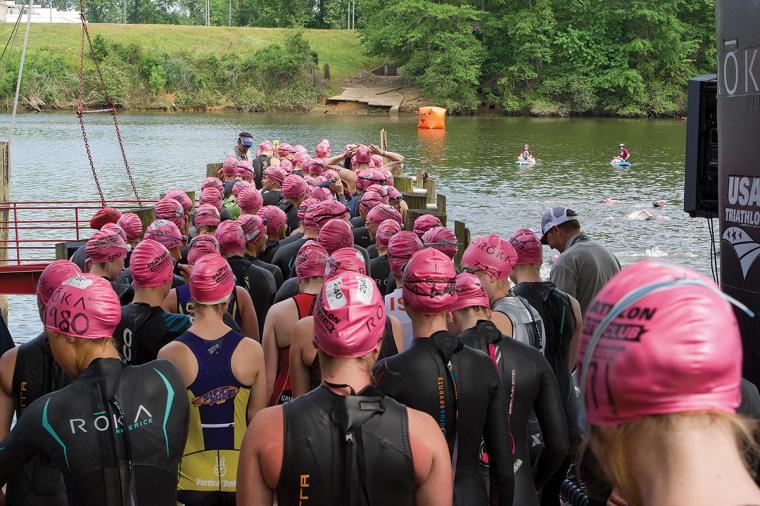

And while that, plus a full competition schedule for the year ahead, add up to great news, they’re hardly the only projects USA Triathlon has in the works. Tim Yount, Chief Sport Development Officer, and Caryn Maconi, Marketing and Public Relations Senior Manager, sat down with SDM to discuss the outlook for the organization, as well as the sport.
Triathlon is one of the sports people have been able to train for in isolation and USA Triathlon has made the most of that by offering virtual events. What kind of engagement did you see with those?
Caryn Maconi: USA Triathlon hosted three virtual events in 2020 and saw more than 10,000 total participants across the events. They generated upwards of $170,000, including more than $125,000 in donations to the USA Triathlon Foundation and nearly $50,000 in annual memberships. Approximately one-fifth of the total participants were not USA Triathlon annual members, so it was a great opportunity to introduce beginners to multisport. We hope to see some of those newcomers on the starting line at in-person races soon.
Our 2021 Virtual Series includes three events:
• DreamingSeason National Challenge Competition, which ran from January 14 to February 14
• USA Duathlon Virtual Run-Bike-Run which ran from April 15 to May 3
• Power Within Virtual Tri to Tokyo, which will run from July 19 to September 12
There is data showing that more people discovered outdoor exercise like running and bicycling during quarantine. Do you see that translating into a measurable increase in triathlon participation?
Tim Yount: We’ve witnessed the cycling industry having a huge boom in bike sales. We’re hearing there’s more of a demand for trailhead parking, campsites and other facilities as people get into the outdoors. If people are running and bicycling, that could get them started on a duathlon. Apart from that, the outdoors has also become a great place for people to connect; they can go hiking together or bicycling. I think that was the door that opened during the pandemic; you had people saying, “Let’s go for a walk with the dog,” and that became a natural evolution to do other things outside.
Open water swimming also grew during the pandemic since many pools were closed. Do you think that will contribute to people wanting to participate in triathlon?
Maconi: I think that can only be a benefit because regular open water swims are not something a lot of triathletes get to do. Most of them train 99 percent in pools and on race day, they swim in open water. Swimming more often in open water could give them more confidence. We did a study a few years ago before we started our Time to Tri initiative, and we discovered that one of the roadblocks to starting the sport was a fear of open water swimming.
Yount: Exactly – a pool has lane lines, and you can stop swimming and rest whenever you want. In open water, things are a little more fierce. What we’re hoping to do is leverage our clubs for training sessions to help people become more comfortable about swimming in open water.
With many youth sports and high school sports not being active, are you expecting a younger contingent in the sport as a result of participating in events such as running, cycling and open water swimming, once live triathlons resume?
Maconi: I think we would hope to see the same trend in kids as adults. In the past, we have held events like Splash & Dash to bring children into the sport over the summer. We make it fun, and we try to keep them from taking it too seriously. We’ve also changed our Youth and Junior Nationals; there used to be a cutoff for the age-group races after age 12 and when kids hit 13 and up, they had to be classified as Youth Elite or Junior Elite to participate, which is really competitive. Now, in addition to the Youth Elite and Junior Elite races, our age-group event welcomes athletes all the way up to 18.
Yount: We also have an in-school curriculum about triathlon, and as schools begin to reopen in-person, we’ll get back to that as well.
Triathlon is closing in on its status as an NCAA championship sport. What’s the update on that?
Yount: It’s what I lose sleep over. We have 36 programs at the college level right now and not a night goes by that I don’t think about getting to 40 programs, at which point we will achieve full NCAA Championship status. We were really lucky and got six additions during the pandemic. Unfortunately, we lost our fall season. The energy and excitement are still there, though. We have 30 potential programs in the works; two are ready to be added and another four to five could get there as well. We are really confident about it but of course, with the pandemic, you never know.
We’ve been really fortunate so far and there are a lot of reasons for that. The sport is one of the most affordable for schools to add; I think maybe bowling is one that matches us in that regard. We’ve been leaning on that, and on the other things that make us so attractive to colleges, and I think it has helped.
Has the pandemic changed your site selection process?
Yount: The municipalities are all very different as far as what they will allow, even with outdoor sports. That has created some really tough situations for decision-making. We have not been able to use some places because there are limits on how many people can participate in events.
Maconi: This is almost the trickiest time for us. In some places, events are going on and in some, they are not. There may even be different rules for a state park vs. a private venue in the same area. One reason triathlon is successfully returning in many parts of the U.S. is our USA Triathlon Safe Return to Multisport initiative, which provides race directors with guidelines for how to host events safely in the COVID era (along with best practices for coaches, athletes and officials). This also serves as something event directors can show to local authorities to demonstrate they’ve got a proven plan, which helps them secure the necessary permits to allow a race to go on.
Yount: One example of that is our USA Triathlon Off-Road National Championships scheduled for May 15 in Hewitt, New Jersey. The venue was at a state park, and the race director was initially told it couldn’t go on, but we were able to show them our detailed plans for safety, and as a result, we were able to have the event.
The Tokyo Olympics is on the horizon. Do you see the USA’s participation in triathlon as inspirational to those watching at home? Does USA Triathlon plan any associated promotions to go along with this?
Maconi: That is definitely our goal. We have that kind of opportunity once every four years, or in this case, five years. In Rio, we had a gold medalist, Gwen Jorgensen. This is our chance to get triathlon into the mainstream, with people watching through media outlets like ESPN, Sports Illustrated or NBC’s Today Show. Getting people watching the sport is key. This year, our Olympic and Paralympic campaign is called Tokyo United. Our editorial content, marketing and community engagement opportunities will showcase the resilience our athletes have demonstrated to make it to this peak moment in their careers — as well as the community that has lifted them up along the way.
Yount: Triathlon was first included in the Olympics in Sydney in 2000. We doubled our membership for 10 straight years after that. Who knows how big it can balloon this time? There is a new format this year – mixed relay. It is a fast-paced, high-energy format and it should add a lot to this Games and the next Games.
Maconi: And it’s another medal opportunity.
Yount: When we held our inaugural Legacy Triathlon in Long Beach in 2019, people just came in and watched it and it was a great opportunity for us to say, “These are your Olympic and Paralympic hopefuls.” It was a way to get people engaged with the sport. We’re hoping they watch the Games on TV and say, “I’ve been there and I saw those people.” We’re looking forward to hosting the Legacy Triathlon again this year, which will include the Toyota USA Paratriathlon National Championships. We expect several Tokyo-bound Paralympic athletes to be there competing in what will be their final race in the U.S. before the Paralympic Games. SDM


